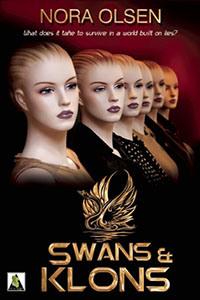
Teen dystopian is a huge genre right now, and I’m used to getting engrossed in giant trilogies contained in it (like The Hunger Games, Divergent, Chaos Walking–sadly, all nonlesbian). Compared to that, a 186-page novel is practically a short story. And Swans & Klons definitely has enough going on that it could have been stretched into several books with a little padding and expanding on concepts, but there is something refreshing about the conciseness of this book. First, we are introduced to the world. Rubric lives in a dystopian future society populated entirely by women (men of the past were all struck with “cretenism”). People are grown in vats in a laboratory, all picked from 300 “Jeepies” (from GP: genotype/phenotype), which are sets of DNA. Society is divided into further types, however: Pannas (women) and Klons: non-human slaves. The beginning couple of chapters set up the world, and then the action begins. This is definitely a quick read.
I’m still not sure exactly what I think of Swans & Klons. It sometimes felt like more of a parody or though experiment than a world to itself, especially the description of men. For instance, a description in a textbook is “The Barbarous Ones . . . [are] peopled by drooling, hairy Cretinous males.” At first I thought the idea of “cretinous males” was hilarious, like men just became more and more distasteful until no one wanted to have to have sex with them to reproduce. [mild spoilers] But when we are introduced to “Cretinous males,” they are men who have severe mental disabilities. The “Barbarous” society they live in don’t describe them or treat them in this way, but there is lots of ableist language and attitudes expressed in the book. Even when Salmon Jo is trying to be understanding, she says that she sees the value in these men because they help you discover more about yourself, and that’s why they’re an asset, it still seemed pretty dismissive of these people’s value in themselves. I’m not sure about their role in the “Barbarous” society, where all men have these disabilities. In some ways it did seem respectful, but I still felt a little uncomfortable–I guess because they’re still seen as a separate class, perceived as innocent, childlike, etc. I’d like to hear other people’s opinions about this aspect. [end spoilers]
I did like that Rubric and her “schatzie” (or “girlfriend”; there is a lot of slang in Swans & Klons, which for the most part I liked, other than “cretinous males” and “barbarous ones”, which doesn’t sound realistic) struggle with their newfound disgust with the way their society is structured. They wonder whether it’s worth fighting a seemingly impossible battle, whether things are really as bad as they think, whether the “other side” is really any better, etc. Revolution is not an easy or peaceful process. Even trying to imagine or work towards it is messy and exhausting. I liked that Swans & Klons didn’t offer easy answers.
There were a lot of things to think about brought up in this book, and because it’s so short, they aren’t addressed in depth. For example, everyone in Society is cloned from one of 300 sets of DNA, meaning that many people have identical DNA. It is assumed that this will determine your personality to a large extent. Once a Panna (woman, not Klon) turns 16, she is paired up with an older person of her same Jeepie. The older Panna mentors the younger one. Jeepies usually are grouped in the same jobs. Klons have the same Jeepies, but they are second-class citizens, altered to not be human, to be less intelligent, more hardworking, etc. They do all of the manual labor and child rearing, leaving Panna to artistic and prestigious jobs. Society definitely reinforces that your genes determine your future, but it is unclear to which extent the book as a whole agrees with that assessment. I do feel like Swans & Klons has a whole world imagined, but we do just see glimpses of some part of it.
[vague spoilers about ending, highlight to read] At first I really thought we were going to get a 1984-esque ending, which actually would have been pretty cool. Some part of the end might seem a little too neat for some people, but I was surprised. And at the very end, I liked the none-of-the-above, open-ended conclusion. It left some questions, and there is definitely a whole other story ahead of them (not one that’s going to be, or necessarily needs to be, written, but still), but I found it to be satisfying, especially considering how ambitious it is to fit a story about a whole dystopian society into such a slim book. [end spoilers]
Despite some reservations, I did enjoy this book, and I would recommend it with those caveats. I would love to hear other people’s opinions on this one! It is nice to have a lesbian teen dystopia, that’s for sure. Hopefully there are more on the way!
